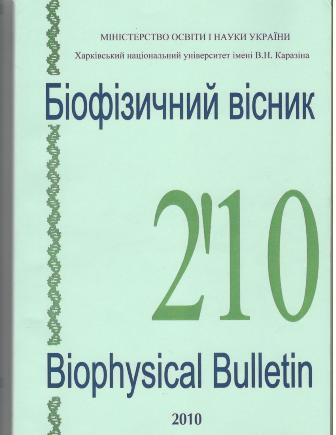Lipid-mediated lysozyme aggregation: förster resonance energy transfer study
Abstract
Aggregation of proteins into insoluble complexes is intimately linked to pathogenesis of several
neurodegenerative diseases. Protein aggregation is commonly regarded as nonspecific coagulation of
incompletely folded or partially denaturated polypeptides, driven by interaction between the exposed
hydrophobic patches. Accumulating evidence indicates that protein self-association can be induced by
protein-lipid interactions. The present study addresses a problem of aggregation behavior of lysozyme
(Lz) bound to model membranes composed of phosphatidylcholine (PC) and phosphatidylglycerol (PG)
(8:2). The formation of Lz assemblies in lipid environment has been monitored by measuring steady-state
resonance energy transfer (FRET). Several donor-acceptor pairs have been employed: tryptophan (Trp) –
pyrene, pyrene – fluorescein 5’-isothiocyanate (FITC) and FITC – rhodamine-isothiocyanate (RITC).
Fluorescence spectra of pyrene maleimide-labelled Lz (Lz-PM) recorded at different lipid-to-protein
molar ratios (L:P) with excitation wavelength of 296 nm were featured by three bands corresponding to
Trp, pyrene monomer and excimer emission. Analysis of the shape of emission spectra showed that the
ratio of PM to Trp intensity rises with increasing Lz-PM concentration and decreasing L:P values from
379 to 77. This effect is most probably to arise from the enhanced FRET between Trp and pyrene. The
finding that the magnitude of this effect depends on protein concentration suggests that FRET
enhancement is caused by the formation of protein aggregates. The same result was obtained with Lzattached pyrene as donor and Lz-attached FITC as acceptor – the efficiency of energy transfer increased
with increasing total protein concentration and decreasing L:P. Notably, the most pronounced increase of
energy transfer efficiency was observed at surface coverage ca. 38 lipids per one protein molecule
suggesting that this L:P value is critical for formation of Lz self-associates. The assumption that Lz forms
aggregates in membrane environment is also corroborated by the quantitative analysis of FRET between
FITC and RITC. The distance between FITC and RITC was found to be ca. 8 nm which exceeds the
dimensions of Lz molecule by 2-2.5 times, lending additional support to the idea about Lz selfassociation in lipid surroundings.
Downloads
References
2. G.P. Gorbenko, P.K.J. Kinnunen, The role of lipid-protein interactions in amyloid-type protein fibril formation // Chem. Phys. Lipids. 2006. V. 141. P. 72-82.
3. C.M. Dobson, The structural basis of protein folding and its links with human disease // Philos. Trans. Soc. Lond. Ser. B. 2001. V. 356. P. 133-145.
4. J.D. Knight, A.D. Miranker, Phospholipid catalysis of diabetic amyloid assembly // J. Mol. Biol. 2004. V. 341. P. 1175-1187.
5. S. Benjwal, S. Verma, K.H. Röhm, O. Gursky, Monitoring protein aggregation during thermal unfolding in circular dichroism experiments // Protein Sci. 2006. V. 15. P. 635-639.
6. C. McAllister, M.A. Karymov, Y. Kawano, A.Y. Lushnikov, A. Mikheikin, V.N. Uversky, Y.L. Lyubchenko, Protein interactions and misfolding analyzed by AFM force spectroscopy // J. Mol. Biol. V. 2005 V. 354. P. 1028-1042.
7. S.S. Wang, K.N. Liu, Y.C. Lu, Amyloid fibrillation of hen egg-white lysozyme is inhibited by TCEP // Biochem. Biophys. Res. Commun. 2009. V. 381. P. 639-642.
8. A.P. Pandey, F. Haque, J.C. Rochet, J.S. Hovis, Clustering of α-synuclein on supported lipid bilayers: role of anionic lipid, protein, and divalent ion concentration // Biophys. J. 2009. V. 96. P. 540-551.
9. M. Li, L.G. Reddy, R. Bennett, N.D. Silva, J. Larry, R. Jones, D.D. Thomas, A fluorescence energy transfer method for analyzing protein oligomeric structure: application to phospholamban // Biophys. J. 1999. V. 76. P. 2587-2599.
10. I. Sepkhanova, M. Drescher, N.J. Meeuwenoord, R. Limpens, R. Koning, D.V. Filippov, M. Huber, Monitoring Alzheimer amyloid peptide aggregation by EPR // Appl. Magn. Reson. 2009. 36. 209-222.
11. A. Naito, I. Kawamura, Solid-state NMR as a method to reveal structure and membrane-interaction of amyloidogenic proteins and peptides // Biochim. Biophys. Acta. 2007. V. 1768. P. 1900-1912.
12. M. Bokvist, F. Lindström, A. Watts, G. Gröbner, Two types of Alzheimer’s β-amyloid (1-40) peptide membrane interactions: aggregation preventing transmembrane anchoring versus accelerated surface fibril formation // J. Mol. Biol. 2004. V. 335. P. 1039-1049.
13. B. Mui, L. Chow, M. Hope, Extrusion technique to generate liposomes of defined size // Meth. Enzymol. 2003. V. 367. P. 3-14.
14. J.R. Lakowicz, Principles of fluorescence spectroscopy, 2006, Springer: New York.
Authors who publish with this journal agree to the following terms:
- Authors retain copyright and grant the journal right of first publication with the work simultaneously licensed under a Creative Commons Attribution License that allows others to share the work with an acknowledgement of the work's authorship and initial publication in this journal.
- Authors are able to enter into separate, additional contractual arrangements for the non-exclusive distribution of the journal's published version of the work (e.g., post it to an institutional repository or publish it in a book), with an acknowledgement of its initial publication in this journal.
- Authors are permitted and encouraged to post their work online (e.g., in institutional repositories or on their website) prior to and during the submission process, as it can lead to productive exchanges, as well as earlier and greater citation of published work (See The Effect of Open Access).





